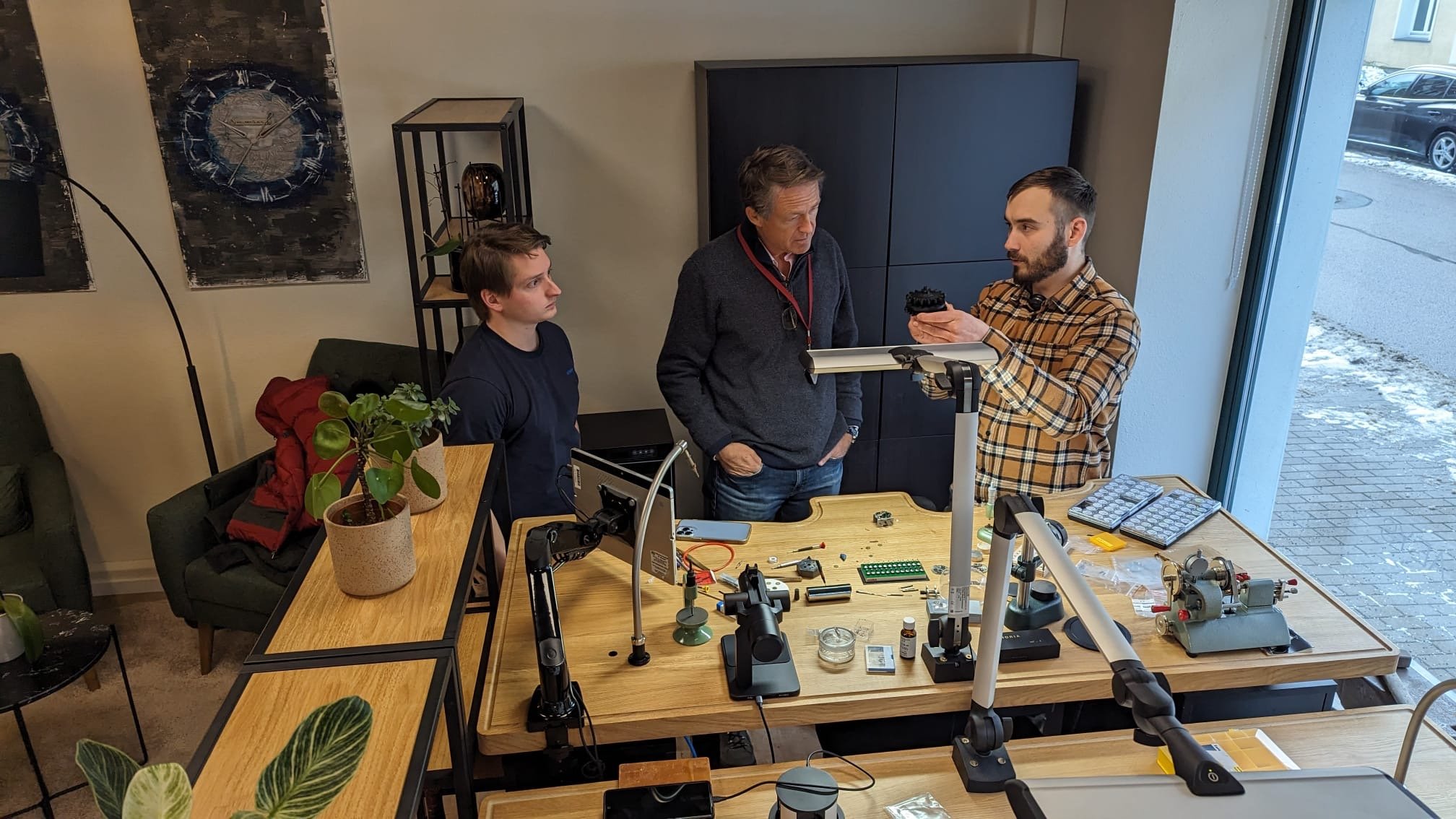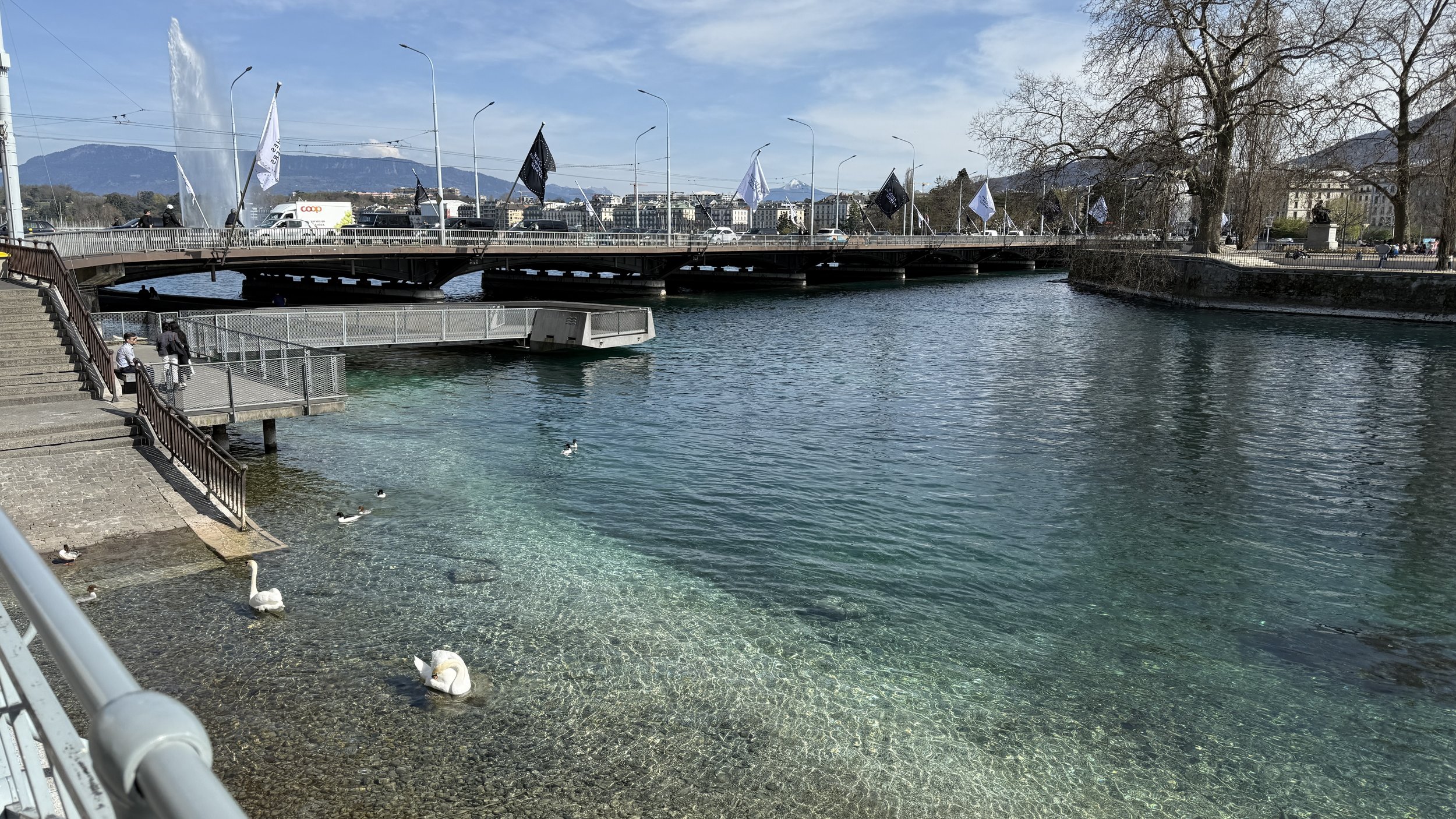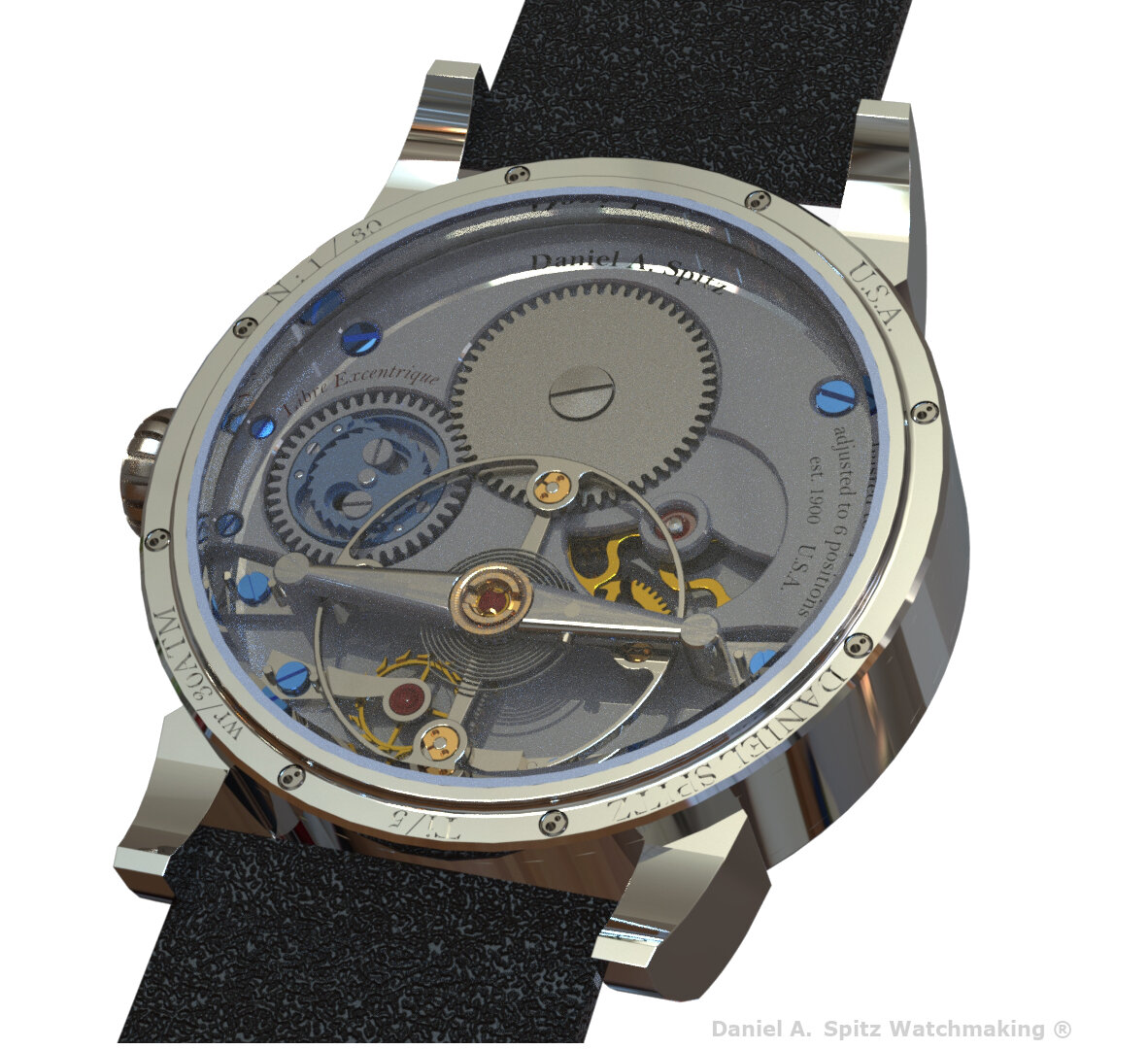Spring weather in Geneva by the Rhone river.
Struthers Watchmakers, U.K. visit Dec 2024
I made the trek over to Leek, Staffordshire from North Wales where I was staying with family over the Christmas Holidays. I had to drop off family members at Manchester airport at 6.30am, so headed down towards Leek in the dark of winter. I had set up our meeting prior with Dr. Rebecca & Craig Struthers and they kindly agreed to meet me quite early on the Sunday morning after Christmas Day. No coffee shops were open in Leek until 8am, however I got to see around the center of this lovely old town, a former textile mill town where the Struthers moved their workshop to a few years ago.
The Town square in Leek
The cobblestone center of town.
We had arranged to meet around 8am, so I headed over there as soon as I could grab a coffee. A short drive to the old mill building, where Craig & Rebecca have their atelier.
The non-descript doorway in the old Mill building, the “CRS” logo is all that announces them.
I was greeted by Craig with a smile and we headed upstairs. The new space is quite a bit smaller than their old space I visited back in 2019, in the Jewellery Quarter of Birmingham. They have their trusty old but restored “named” machines along one wall and their watchmaking benches facing each other as before. Familiar tools of the trade!
I was shown, but not allowed to take photos, a Project 248 model in red gold with a lovely black enamel dial that was in the workshop for some tweeking. As with many new watch models that are eagerly wanted on the wrists of those who order them from artisanal independent watchmakers, there is often a teething period where the actual live usage on the wrist of said wristwatch, reveals small issues that weren’t anticipated in the original design or protyping stage. There is nothing like real daily wear and tear on a wristwatch, to properly field test a watch design. Rare does the small artisanal independent have the time and ability to do this extensively enough to cover all types of events that can occur with wearing a watch. Luckily, this owner is understanding and knows that he/she is contributing massively to the Struthers’ ability to improve upon their work. Future collectors will benefit and in the spirit of being a patron, as the early adopters so often are, those collectors typically will readily and happily help out the watchmaker. My suspicion here may be off base, but I suspect I’m pretty close to the reality, so my hat’s off to the collector for supporting Rebecca & Craig in the early days.
Dr. Rebecca Struthers & Craig Struthers.
One thing to note that has changed since my prior visit, is that they have changed their business model now to reflect where they want to focus their precious time. They are only producing Project 248 watches from now on. No other models will be available, nor any outside repair or restoration work will be entertained by the Struthers anymore. My belief is that with this strict focus on one watch, they will be able to dedicate their resources more efficiently and build more watches for collectors, which is good news for those eagerly waiting a Struthers Project 248 watch!
I found this early production Project 248 watch to be quite charming, elegant and very well made for a first effort. Not an easy task to accomplish, it features a very slow beat balance wheel that is visible on the back of the caliber. The beautifully hand engraved movement in the classically English floral style is a joy to see. German silver has that lovely warm feel to it and the slow oscillating balance wheel, a real treat. They use several master craftspeople in different fields as in the old days. A superb hand engraver, Florian Guellert, does exquisite work. The enamel dial is created up in Glasgow, by AnOrdain, the enamel dial specialists in the UK.
Some of the heavier equipment in the outer office space.
A goldsmiths bench, that is well used. Rebecca initially trained as a goldsmith prior to moving over to watchmaking.
The Struthers explained what they are up to next with their inhouse watch Project 248, exciting things to come and those supporters will be well rewarded. I was told in confidence a couple of upcoming aspects of future watches, and these will remain untold until such time that these two people decide to reveal to the world, what they are up to. I realize that so much of their world is in flux and the mistake of revealing a feature or design too early can have negative consequences down the road.
I strongly recommend Rebecca’s book, Hands of Time, to anyone remotely interested in Horology and the history of watchmaking. As the sole PhD in Horology, Rebecca’s brilliant mind and experience is laid bare for the reader. Her documentation and way of writing is easy reading even for the non technical watch buff. I thoroughly enjoyed this book, and it definitely gives one a better of sense of the watchmaker that Rebecca has become.
The English and USA versions. Had to have both!
I am always in awe of artisanal independent watchmakers that have dedicated their lives to creating mechanical wristwatches to the best of their ability and who focus on fine hand work to reveal their understanding of the classical ways of finishing that improves and longevity, look and feel of a watch. Rebecca and Craig certainly embody this philosophy.
One of Craig’s many illustrations found within the brilliant book.
Thank you Rebecca and Craig for another lovely visit.
Cheers,
Tim
State of the Market 2/12/24
I arrived into a snowy Dresden from Geneva via Frankfurt back in early December for a visit with several of my independent watchmaker’s, some of whose work I have represented for almost 20 years. The Dresden airport is a shiny example of federal infrastructure funds being put to good use, albeit without fully understanding the commercial situation and location. There is not much call for flying into Dresden, when trains are efficient, economical and go direct to major international airports. Rather similar to many commercial watch brands. Too many un-saleable models, created under the concept that if we build it they will buy. The end user is in the driving seat more and more in todays world and the days of, and the ability, to foist off poorly designed and executed watches on unsuspecting and/or ignorant buyers, is rapidly coming to a close. The transparency and therefore honesty now required by the buyers is changing the market place, and it couldn’t come at a better time. The money involved in “Luxury Watches” is big and real. The likes of LVMH, Swatch Group and Richemont, are serious players who expect to continue to make good returns on their investments and be paying dividends to stock holders. They are more and more having their proverbial “feet held to the fire” and this is good for consumers. Honesty in the business of watchmaking, has shall we say “Not always been of paramount importance” in the marketing and selling of wristwatches. It’s high time that changed, and that is why I haven’t been associated with that end of the business since 2009. My focus has been the artisanal Independent Watchmaker and their craft. My sense in 2003, when I began along this path was that I was entering into a more honest and authentic albeit tiny niche of horology. The players seemed to represent a different end product, even though there were similarities to the main stream big marketed brands. It was perhaps an educated hunch more so that an analytical evaluation of what they were doing. For one, there was gobs of transparency from the initial watchmaker I began a commercial relationship with, Peter Speake. His fledgling company, The Watch Workshop, produced tiny quantities of watches under the Speake-Marin name. Never before had I come across a watchmaker or brand that used fired enamel dials on their entry level watches, nor had the beautiful hand finishing on it’s rotor. This was massively rare and getting to meet Peter, hear his story during Baselworld 2003, would change me and how I looked at the watch business going forward. His openess about his Caliber FW2012 in the Piccadilly, the base was the “tractor motor” caliber ETA 2824, which began life a Longines caliber from memory, was used for longevity and consistency. His upgrades of the automatic winding bridge and highly hand finished “Topping Tool” motif rotor made for what I believe is a solid and highly reliable caliber. It also allowed Peter to make and deliver watches without to massive investment required to design and execute one’s own “inhouse caliber”. It would be several years later that he was finally able to realize that dream with the SM2 caliber, albeit a short lived production run, prior to his leaving his eponymous company.
I didn’t know the degree to which this seminal meeting would affect me until many years later. I was still working with many of the legendary big marketed brands in my store. However a comment that Peter made to me a couple of years later in 2005 or 2006, remains with me. It was in response to me suggesting to him, that I thought a shop that only carried small production artisanal independent watchmakers work, was the what I saw for the future. This was due to the confusion and lack of knowledge with most watch consumers as to the actual value of fine artisanal watchmaking compared to relative mass produced on a production line watchmaking. Placing a steel Speake-Marin Piccadilly in steel next to Ulysse Nardin San Marco in steel or an IWC Mark XV, with the contrasting pricing, made for much confusion amongst watch buyers. Peter’s response was that, “how would I get buyers into the shop if I didn’t have the big marketed brands advertising of their products?” He didn’t see how it would or could work. In 2006, it probably would not have. However I believed this was the future for me. I have proven this concept could work.
Now, as ever, the retail selling landscape is changing and I now am connected to my clients and watchmakers through various websites, social media, email and messaging. The days of requiring a physical shop, are no longer needed for my niche world of horology. What is still needed for me, is doing the leg work to meet face to face with the watchmakers in their workshops or at the very least, a trade fair, such as the AHCI events held annually. I do have my corp. office in downtown San Francisco where I meet in person with clients.
The tools one has now for reaching the right type of buyers of artisanal wristwatches, has changed the dynamics even more, to benefit collectors and buyers, and it is a better and more honest landscape for consumers to make their best choices. The relationship is still very important, but how those relationships occur is forever changed and I believe for the better!
The latest American artisanal Independent Watchmaker breaks cover
Compelling is a word I do use often when it comes to independent watchmaking. The products and the people behind them both contribute to this. As one delves deeper, finding out who these amazing artisan watchmakers really are, what motivates them to create and why they produce these superb executions of micro-mechanical horological art, it grabs the heartstrings.
Recently, I began a conversation with a fellow, who I’d followed for a year or so on social media, observing and noting his direction, talents and general demeanor. His claim to fame in the horology field was mostly with big brands, graduating quickly from what Watchmakers know as the most prestigious complication school in Switzerland, WOSTEP school in Neuchatel. Then after owning a few private restoration service centers he went onto heading up Chopard complications atelier for North and South America, designing & teaching Chopard’s in-house complicated watchmaking courses to name a few. He also happens to be the former insane (in a good way!!!) lead guitarist and co-founding member of the multiple Grammy nominated heavy metal band Anthrax, so music, another extremely time sensitive exercise, is in his blood.
He looked and sounded like the part, so more observation ensued. It was only in the past 3 months or so, did I realize that he had the chops for and had in fact created a new caliber! Excited to see this, I hungrily absorbed each new revelation and my admiration gained steam. Having followed and worked with several other Haute Horlogerie or high end watchmaking independent watchmakers here in the USA, I was intrigued and excited for what appeared to be a unique watchmaker doing what no one had done here in my adopted country, for around 100yrs.
A wholly designed new caliber, that is being made in the USA by one guy, an American named Dan Spitz.
One can read up on his website about his childhood, which is where he got the horology bug, by being exposed to high end watches through his grandfather’s vintage watch and jewelry store in the Catskill Mountains of upstate NY. As an artist, he is compelled to do what he does at an extraordinary high level of passion. His skills have been honed over 40yrs and counts many of the current crop of artisan independent watchmakers as dear friends as Dan and most have all come out of the WOSTEP school in Neuchatel around the same time. He admires their skill, courage and passion to create what is not an easy life for themselves. There are many barriers in the traditional watch business, and being able to create his own caliber, from the ground up, as an original mechanical design in the US is a task not easily done, in fact, not since the pocket watch era has it been. Years of study and practice to hone his traditional watchmaking skills are only one part, additional years of school to learn how to program the Watchmaking specific CNC machine’s (he’s also built himself) together with the 3D CAD/CAM needed for producing small series of the worlds most precise parts, repeatedly, is a whole field of study unto itself. Dan has an impressive array of skills with which to practice and aim to perfect his craft.
Dan has spent years acquiring and restoring extremely rare precision Swiss ancient machines for the manufacture all by himself and spent the hours and money to acquire many traditional old school hand tools with which to deliver his craft. Unless one wants to only make a watch or two a year, at this high level of execution, with all the hand finishing that goes into it, a prototype CNC machine is required to produce the accuracy of parts necessary. This accuracy is what I’m told around -2 microns and +0 microns. It all takes time and for one person to master all these different disciplines is very, very rare.
From my perspective, there are perhaps less than 25 people on the planet with the skillset Dan has. When one considers all the tasks a Master has to accomplish in order to get to this place currently and be able to produce a handmade watch of this quality by himself. That speaks volumes to me as an observer specifically of the Independent Watchmaking field for over 20 yrs now.
I’m excited to announce that Dan & I have entered into an agreement whereby Independent in Time have agreed to represent his work here in the USA and aid in his sales by providing clients a person to talk to, answer questions and promote his work together with the other renowned Independent artisanal Watchmakers who I’ve been working with for years. I’m happy to support American Independent Watchmaking at this level and we look forward to expanding the scope of Dan’s work. In addition, I’m supporting (and I think we all should) him by helping to eventually bring in up to three USA traditionally trained watchmakers who want learn the production aspects of independence in America from a Master Watchmaker, and gain practical skills, while helping him produce the still tiny quantities he plans on.
His workshop with the myriad of tools and rare machines, will be available for use by these watchmakers “after hours” for their own projects and ultimately we want to create and help fund a scholarship like organization that aids these young and trained apprenticing watchmakers to gain the tools & equipment required to help USA independent watchmaking, and themselves get their micro mechanical art out there. Once they’ve gained the skills needed at Dan’s manufacture the plan is to help them further make sure there first timepieces get into the hands of collectors that would appreciate and support American Haute Horlogerie, at it’s highest form. Open source watchmaking is what he is about and Dan is keen to create a legacy for American watchmaking that he feels proud of with this next stage of his horological work.
Let’s not forget Dan’s new Libre’ Excentrique oil-less escapement is part of a 4 year research and development partnership with some of the planets finest Watchmakers who develop for some of the big brands. An open source escapement that will be available to these young Watchmakers to use, for free!
I look forward to working with Dan for many years to come and helping him forge this long forgotten path for American Watchmaking.
Cheers,
Tim
Honored to be featured in the NAWCC magazine...
A rather lovely article written by the superb clock & watchmaker David Walter FBHI that shows my amazing Watchmakers Regulator precision pendulum clock, I commissioned for Independent in Time. It was a six month project that culminated in David coming to install the clock the weekend I hosted the Horological Society of New York's traveling watchmaking classes in San Diego, over the weekend of Feb. 10-11th, 2018.
I had received several images from David over the months showing various stages of completion for the movt. dial and hands. I wasn't quite ready for how elegant and big the clock was once inside the stained ash case and on the wall! I'm thrilled to have this piece hanging in a prominent position and to continue supporting Independent Horology and in this case clock making, particularly from a fellow USA based transplant.
More pics to come, suffice to say this was a very happy moment for me!
Thank you David.
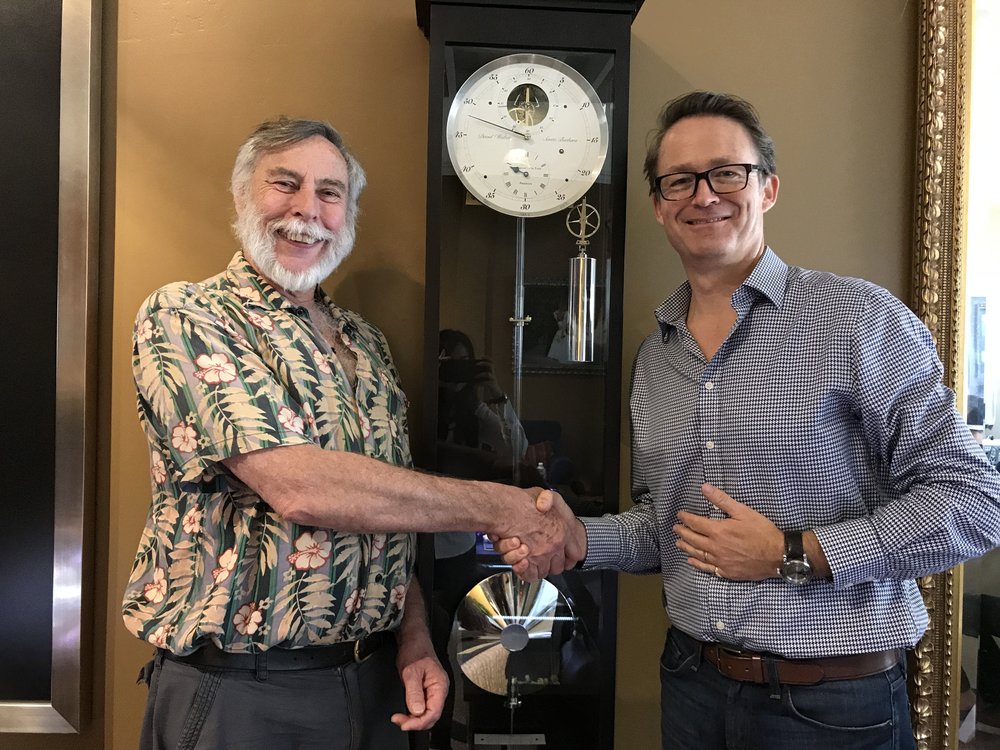
More musings on the branded "watch business"...
I had a great meeting yesterday with a representative of a small Independent brand. The gentleman had sent me a letter prior to the meeting with the usual PR fluff about the latest manufacturing capabilities etc. etc. and that he'd reveal more in the meeting...
I had met the owner of the brand several years ago, when he'd made a trip to the US and stopped in Solana Beach.
I am familiar with the company, it's products and the general brand.
So, in walks a new chap, confident and comfortable in his role...after introductions, he starts in with the fairly typical company info. about what they are doing now and the latest products, that use some of the original founder's (although he is no longer at the bench nor designs anything to do with the current watches) special skills, combined with the modern manufacturing technology and craft of hand finishing and assembly of some 600 watches a year.
After telling him I choose to work with individual Independent Watchmakers, rather than brands he took it in stride and continued to attempt to persuade me that his company and ours could be a good fit, etc. etc. I like the guy, his passion, his knowledge and his presentation were all compelling, but ultimately I'm not interested in representing a marketed brand, which is what this truly is. Small & Independent, yes... good products, yes....passionate representative, yes....but a name acquired and a manufacturing business built in the Swiss tradition, not terribly interested I'm afraid.
Now if I were to open another store that focused on small Independent Brands, they would be in the running, together with some other Independent brands that I think offer good value and make very good products of original designs etc. etc.
This company's technical ability is impressive, and I was shown images of an upcoming unique complication being developed, a working prototype was shown in a video. Very cool!
There is a master Watchmaker who is the technical director of the brand, the mechanical genius creating these wonders, I just wish the focus was more on him rather than utilizing an old name and doing the typical Swiss watchmaking business, that is all too prevalent and less compelling to me, the more time spend in this world of mechanical watchmaking. Marketing and branding isn't for me.
Why write this, well it reminded me of "why" I do what I do and reminded me of the compelling reasons why the Independent Watchmakers make their watches. Understanding "Why" a watchmaker makes a specific watch is more compelling to me than "What" or "How". It's the fuzzy stuff, difficult to quantify, that I like to learn about and share with those willing to listen. In this day and age, there are plenty of watch brands to go around, arguably too many...finding true artisans of horology isn't common, but once discovered, well that is the watch arena where I want to exist.
Cheers to all, have a brilliant weekend,
Tim
2016 Summer thoughts...
Dear Friends,
Well the summer is here in spades in Solana Beach!
It is for me a moment to reflect a little, having just had my 49th birthday this week, entering my 50th year has given me pause to think. I made a major change to my life when I created Independent in Time, the business that reflected what I believed was the professional direction I felt compelled to follow, having been a fairly traditional big brand independent retailer since 2000 in the San Francisco Bay Area.
This past couple of weeks with the Brexit referendum in my country of birth, the financial, political & social turmoil that this has caused and the impending Independence Day celebration that my family & friends here in the USA celebrate vigorously, I'm taking a moment to look at where I'm at with regards the Independent Watchmaking world that I participate in professionally. How this reflects my wishes for Horology in general and Independent Watchmaking in the big wide world and my unwavering support for these artisanal watchmakers, whose life path it is to create arguably archaic micro mechanical works of horological art. Utilitarian items although Utopian in concept, don't excite the soul and give pleasure to life. Human beings I believe fervently need some form of artistry in their lives.

Oftentimes, and in fact for much of my professional career, I've followed my heart and gut feeling over what others have recommended. Financially, I suppose I've suffered somewhat, but at the end of the day I believe it is the correct decision for me. In doing my part to spread the word of Independent Watchmaking, I feel fortunate and honored to have this as my "daily work".
I'm excited to be able to offer these superb pieces of micro-mechanical horological art, representing each of their maker's blood, sweat and tears...and I thank you for the support of Independent Watchmaking,
Cheers,
Tim
SalonQP 2014, a quick London trip.
A last minute business trip quickly came together last weekend, and within 4 days of booking tickets, I was flying to my old country. Leaving San Diego in the morning, with bright blue skies and the temperature heading into the low 80's as I boarded my plane, I was excited to finally make this relatively new watch show held at the quite famous Saatchi Gallery off The Kings Road, Chelsea in London.

Sunny San Diego airport.
Salon QP is in it's 5th year and is found in a rather ritzy location for a watch show. I had until now failed to justify to myself the time & money to attend: my timing though was impeccable for the trip and coincided perfectly with the SalonQP.

The Gatwick Express heads over the Thames a few minutes before arriving into Victoria.
Arriving into a cold and windy London Gatwick, I jumped aboard the "Gatwick Express" for Victoria and headed to the Saatchi Gallery. Upon arriving I headed upstairs into the galleries where many of my friends were exhibiting their wares. Of course, there were many familiar faces too from the "Watch business", writers, photographers, bloggers, investors and marketing folk! When one attends Basel for 14 years, a certain amount of "Watch business" people become familiar.

Alex & Marco from L&H in Dresden.
I'm happy to say that Marco Lang and his colleague Alex were in attendance showing off their new highly complicated anniversary watch, the Augustus with it's magnificent Caliber VII with 18K rose gold bridges, cocks and wheels! I saw the prototype in Basel, so we chatted about business in general and I was then off to my next stop.

Stepan Sarpaneva is a brilliant watchmaker and designer of watches. He has been working on a Tourbillon for a few months, and having followed his progress via facebook, I was excited to see the running prototype at his stand. He also had brought along the enamel dialed K0 which I was interested to see. As a lover of enamel dials, this was intriguing and in person it didn't disappoint.

The K0 Tourbillon prototype Stepan has been working on for himself!

On the wrist, it has a great look and is very much a Sarpaneva!

The enamel dialed Moonphase beauty!
His use of the iconic grill over the top was in keeping with his design aesthetic. I pressed him to make a trip to the sunny climes of southern California, I know he'd enjoy it, particularly if it occurred during his colder season up North! Close by was my Hungarian friend Aaron Becsei, who showed a proto of his latest piece, the Dignitas, which I'd seen in CAD pics before, but nothing real. It was stunning! His watches have a rather old world styling, maybe a bit gothic and an irregular shape, so they are a bit of an acquired taste. In terms of workmanship, they are stunning and his hand finishing is superb. He also had the splendid Triple Axis tourbillon with him. Again, this piece is a technical tour de force and the cages are gorgeous. Very rarely a fan of regulator watches, this one I appreciate for it's craftsmanship and superb finishing, but style wise I find it misses the mark for me. Oh well, as they say, you can't please everyone all the time.
I had an appointment with my friend Richard from Pinion, who has been keen for us to find a working relationship. I want to help him, as I believe his commitment to English watchmaking, while freely admitting to using good Swiss calibers, is something worth supporting. I wasn't terribly excited about their first offering, the Axis Automatic, but upon seeing the Axis Pure, I was seeing a lovely watch.

The Pinion Pure cased in marine bronze at 42mm.
The dial work and case are lovely, with a reliable ETA 6498 beating inside, here is a watch that has style and good design. I grabbed a bronze piece, as I felt the high polish steel was a bit bright for me. The other watch I was eager to see was the Revival 1969 chrono, which features a new old stock Valjoux 7734 caliber never assembled from 1969 until now!

Pinion Revival 1969.
Again I loved the dial and being familiar with this caliber having owned a superb Habring2 chrono with it, I was excited to see what Rich and his team had done with it. Limited by how many NOS calibers they have, an edition of 100 pieces will be made, and at $6850 I think it represents quite a lovely hand wind chrono.

Please excuse the non optimum photo quality, this was an iphone pic!
I went over to see my slightly crazed French friend, Vianney and catch up with him after stopping and talking to Kari Voutilainen for 5 minutes. Kari had a couple of gems in his little showcase, I had to examine the exquisite tourbillon of course but the piece that really grabbed my focus was a gorgeous pale blue guilloche dialed Vingt-8 GMT. Kari's dials are getting quite adventurous in some cases, this was a bit of a departure from his usual classic look.
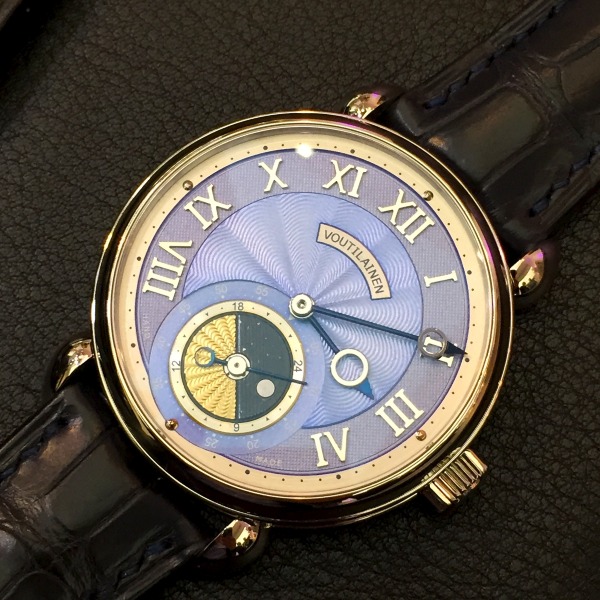
Kari's latest Vingt-8 GMT with the GMT dial at 6 o'clock.

He also showed me a Vingt-8 with striking orangey-red numerals and discs on his modified Breguet hands. Kari was very excited about the English market for his work, saying his English clients really were huge fans of his work, truly appreciating his style and craftsmanship, with several clients owning more than one of his pieces! To me it made perfect sense, with the natural appreciation for classical style and exquisite workmanship, I could imagine him finding many a happy client in England. Might be biased here! Anyway, as I got to Vianney's showcase, he was readying himself to face the British weather for a lunch. Kindly inviting me, I agreed to join him and another great watchmaker, Antoine Presuzio for a bite to eat on the Kings Road.

Antoine's latest project with his son, an oversized automatic with power reserve and mixed metal case & lugs. A bit too "bling" for my taste! They apparently have no problem selling them.
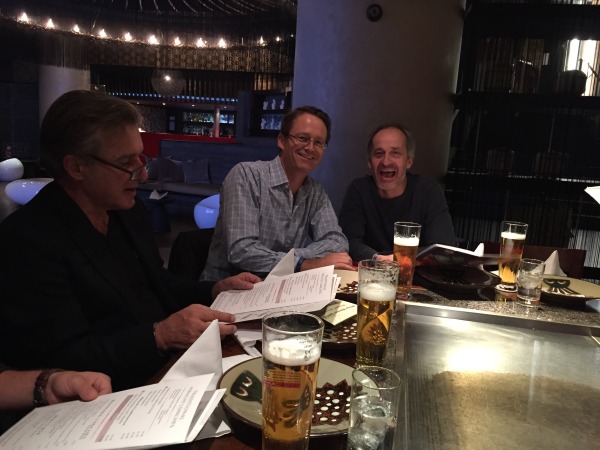
Antoine, yours truly and Vianney.
Funnily enough we ended up in a Japanese sushi restaurant in London. Wouldn't have been my first choice, but as I was a guest, it wasn't my place to decide! Of course we had a great time, and it was a pleasure getting to know Antoine, his son and wife. We returned under a British shower, without the benefit of an umbrella!
I then wandered around taking the sights, many small brands were in attendance, so it was educational being exposed to them. My friend Johannes Jahnke, formally of Lang & Heyne, now reside with his growing family in Switzerland, where he develops calibers for the likes of Christopher Ward and Meistersinger. he showed me the C.W. Ward inhouse automatic he designed for them. It represents quite a value, and as they only sell through their own website, the consumer gets a lot of watch for the money. Of course the buying experience isn't what most of my clients wish for or expect, but it works for them. A different type of business for sure. Bidding him farewell, I bumped into the two genius brothers Grönefeld from Holland, fresh from their win in Geneva at the GPHG, they actually declined a beer!
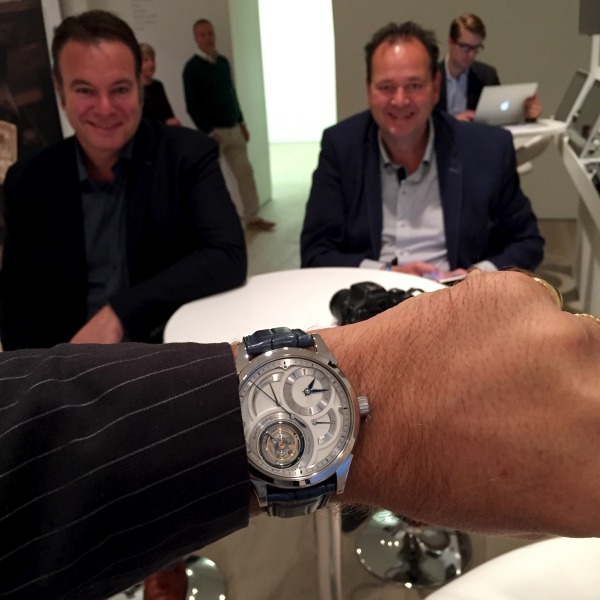
The Parallax Tourbillon and it's creators, Bart & Tim.

Closer up, plain light.

Now some reflected light, to reveal the lovely blued steel hands.
Fortunately they were happy to chat and show me their superlative Parallax Tourbillon. Tim & Bart are two of the more fun and entertaining fellows in the Independent Watchmaking world, so spending time with them is allways good. One day I must make the trek over to their country and visit. On my way out, I stopped by Andreas Strehler's stand, where he was showing his latest creation, the semi-skeleton Papillon with power reserve on the back.
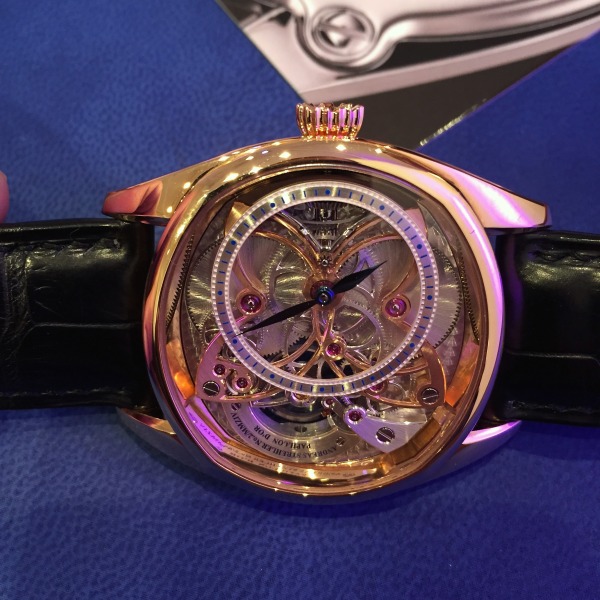
Front, again a poor pic, lighting wasn't great, and the iphone struggled!
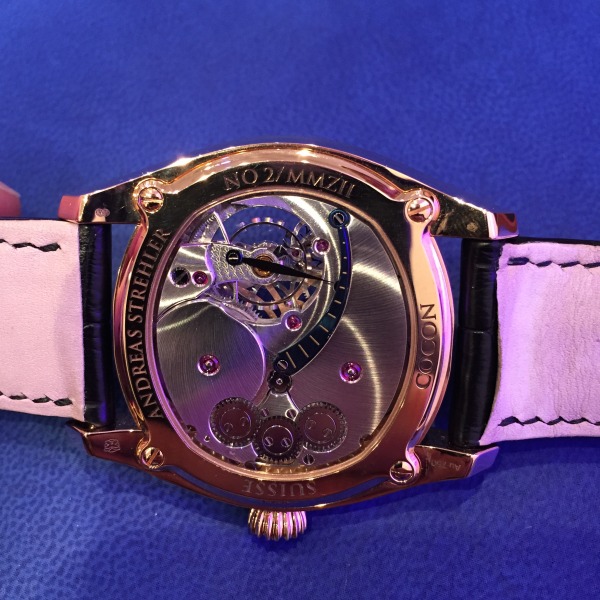
Beautifully hand finished.
Last but not least, Max Busser's colleagues were showing off the latest MB&F Horological Machine. The HM6 is quite something and again touches on several themes, primarily space travel and sports a central tourbillon under a domed crystal. It also had a "Shield" that can be closed over the tourbillon to cover it, sort of like a cloak. The titanium case is "spaceship" in looks and feels amazing on the wrist. Pictures will reveal more than words...
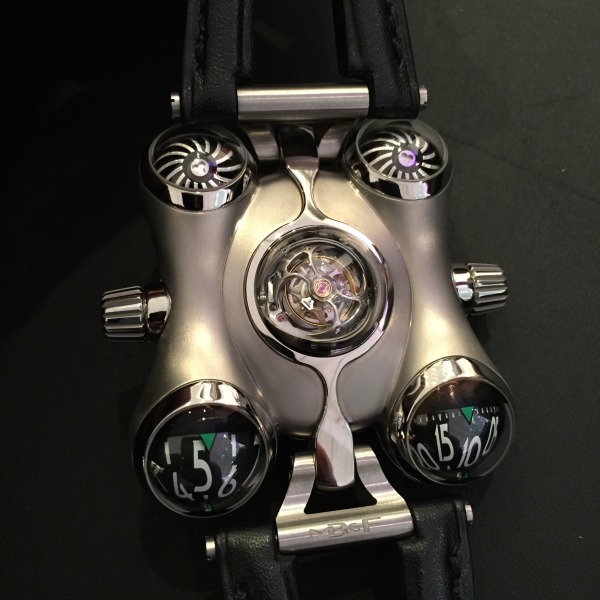
Central flying 60 second tourbillon.

Domed bubbles reveal the hours and minutes similar to the HM3. The Tourbillon is partially "cloaked"

The tourbillon has been cloaked.

The back showing the MB&F green 950 platinum rotor on their caliber.
As I had an appointment with a client in Covent Garden for dinner and to deliver his new Speake-Marin, I had to depart prior to the evening cocktail event, which I suspected was going to be a fun time unfortunately. Such is life when you have to work for a living! No complaints though seriously, as I enjoyed a great seafood dinner with my new friend Graham and got to see his smile as he strapped on his new watch. Acquiring a watch by fellow Englishman, Peter Speake-Marin, was exciting and possibly way past time. Worth waiting for though! We finished up our meeting and I headed off to meet my old friend who I was staying with. The following day I headed over to the island of Jersey to deliver the other Speake-Marin watch. As my folks live there too, I got to spend a couple of days with them prior to returning to the sunny climes of San Diego via a rainy London!
I would encourage any of you in the UK or near by to attend the SalonQP event if possible as one can really spend time with some of the greatest watchmakers on the planet, see their watches in a relaxed and pleasant atmosphere without the crowds and hoards of watch press swarming around Baselworld. I'm only sorry I didn't get to attend the evening event, as that I suspect would be quite fun. They also have several lectures during each day of the show, which I imagine are full of fascinating and useful data. I think I might need to make this an annual trip!
Cheers,
Tim
Just found this short article I wrote 9 years ago about Speake-Marin.
Rereading this today, I still feel the same way about Independent Watchmaking as a whole, and am more compelled to help these guys get their message out and help collectors realize their genius....
"A viewpoint of micro-mechanical wrist art.
I'm going to pen a few words about Speake-Marin watches, in doing so, my challenge is to write more about the watch as an art piece and less about what can often be the rather tedious, the facts and figures regarding the number of jewels etc.
I’ll speak from experience as I have one of Peter’s superb Piccadilly’s, a red gold execution with a lovely porcelain enamel dial sporting those classical black roman numerals that I love.
Those of you who know me well, are aware of my penchant for genuine enamel dials, particularly with roman numerals. It has probably got something to do with growing up in England and seeing the grand-father clocks in various friends homes with their roman numeral faces. Wearing a watch likes this gives me great pleasure and as we all work very hard around here, a reminder that once in a while we should throw ourselves a bone. Now this goes without saying that our spouses/ or significant others probably ought to be taken care of first, but at the end of the day “All work and no play makes jack a dull boy”, so go ahead and treat yourself once in a while.
For me, the most impressive part about Peter is that he is not only a genius watchmaker, capable of creating superb complications, but almost more importantly, able to design an absolutely beautiful watch. I find this a rare quality in the horological world. One typically finds great designers and superb watchmakers collaborating to create lovely watches, so to find a single watchmaker and designer is very rare. Now before I get yelps about what is beautiful, as it is of course fairly subjective, remember this only my viewpoint! It puts Peter into an extremely small and exclusive club. I’m particularly thrilled to see a Brit in this club for obvious reasons.
So I invite you to take a look at Peter’s creations in person, come in and get a feel for what makes him tick. I was intrigued, I think you’ll be also.
Please call me with any questions about Peter or his splendid watches.
Cheers,
Tim"
A ten year journey...from Peter to Keaton!
Martin Braun visits Solana Beach with the Slow Runner
I was blessed to have my dear friend Martin visit and spend a couple of days in Solana Beach, showing eager collectors his amazing new watch from Basel earlier this year, the Slow Runner. This is a worlds first, with a massive Aluminum balance wheel of 24mm that beats at an amazingly slow rate of only 7200beats per hour. Similar to the healthy human heart, it has a mezmerising motion that immediately calms one.
Martin designed this superb piece as he feels high end mechanical watches should be more about slowing down time. We live in such a frenetic time, with mobile smart phones tethering us electronically to each other, that Martin felt his watch could help us reflect upon the benefits of slowing down.

The silvered dial version on the wrist. The second hand makes two beats per second, similar to an old long case clock.
I was able to share Martin with several collectors for a fun evening in Solana Beach, where he showed us his watches and spent several minutes talking about why he decided to create the Slow Runner. He took questions and happily answered them, with humour and grace.
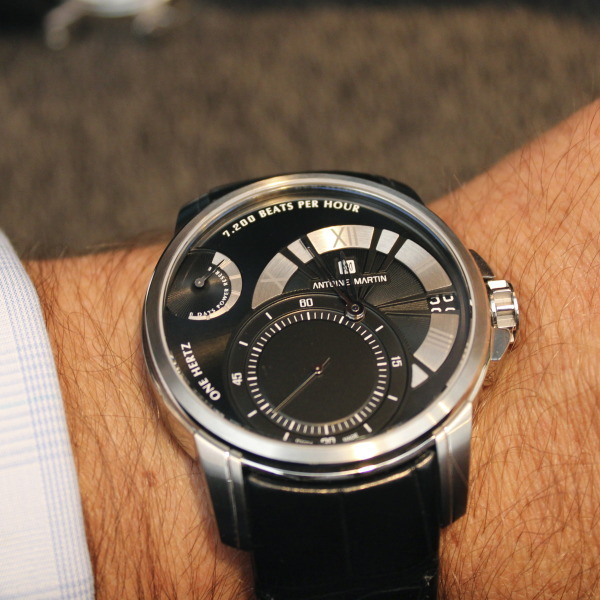
The black dialed version on the wrist.
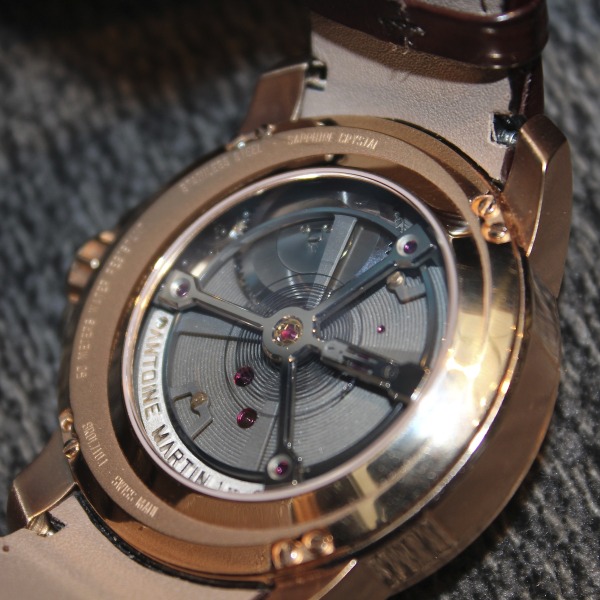
Here is the caseback of the RG version, revealing the massive balance wheel.
Another watch debut at Basel this year was a Flying Tourbillon with grand date. This is a tremendous value proposition when compared to big brand models, especially given the technology found within it. Using Martin's design of silicium escape wheel and anchor, which is more efficient with less friction.

In 18K rose gold, with the huge dial side tourbillon regulator.

This is the steel silvered dial execution, which at approx. CHF72,000 represents tremendous value.
I was able to spend a day with Martin together with friends and show him around a little, tailgating at the San Diego Polo club, which sounds quite fancy, but really isn't! Also a day spent whale watching with two dear friends and passionate watch aficionados, Mike & Mitch. I look forward to getting the first Slow Runners at the beginning of 2014.
Baselworld 2013- Video of Konstantin Chaykin's Camera watch
Baselworld 2013-Video of Slow Runner by Antoine Martin
Musings on Independent watchmaking and the beginning journey for me
At the risk of sounding like a broken record, I thought I'd pen or rather type this little missive about why I have chosen to work in the Independent watchmaking end of the watch business, rather than the broader big brand market or the second hand dealer arena.
Yes, it is a more difficult (read less financially rewarding) way to operate professionally, but infinitely more rewarding as the business aspect of the watch world changes each year.
I saw the change coming almost ten years ago, with the opening in NYC of the first branded boutiques, and I certainly understand why the brands are doing this. As an independent watch store, this had some benefits and disadvantages for me Unfortunately the disadvantages outweighed the benefits rather significantly and it is why when setting up my store three years ago, I chose to only represent real Independent Watchmakers.
One of the reasons I do this, is that these relationships I develop with collectors over the months & years often turn to friendship. A group of like minded individuals reward me with their loyalty and support, as I continue to support the artisanal aspect of fine mechanical watchmaking by helping these Independent watchmakers who have chosen the path less travelled and certainly more difficult, within the watch business. I fully believe that people like to help others if they can, it is a human need on many levels and brings a level of happiness and contentment that other pastimes can rarely offer. It just feels good!
Seeing the joy in a collectors eyes when they first open up a new watch box to reveal that piece they acquired, especially when it often takes months to get sometimes even a year, is amazing and knowing it helped a watchmaker build his little business, is a large part of why I do what I do.
I know that the big brands create many lovely watches, some of which I personally own and would own more if money were no object, however there is that human connection with the watchmaker that cannot be duplicated with a big brand, and it is this aspect that I first found compelling 9 years ago when I started working with Peter Speake-Marin. Back then, we were both in quite different places professionally and personally. I was part of an existing fine jewelry store who were big brand authorized dealers for many great brands such as Ulysse Nardin, Vacheron-Constantin, Glashutte Original etc, etc., whose products I'm still fond of to this day, with quite a healthy annual turn over of several million dollars feeding an expanding business. Two children, married and working to build this business, I came across this fellow Peter, married, no kids, working with his wife and just getting going in his independent phase, having recently created the Watch Workshop to design and make watches under the Speake-Marin name. With an annual production of around 35 pieces, he wasn't making himself wealthy by a long shot. Probably just about covering his bills with a long road ahead, I was immediately taken by his humility and straightforwardness when discussing a potential business relationship over coffee in Basel that initial meeting.
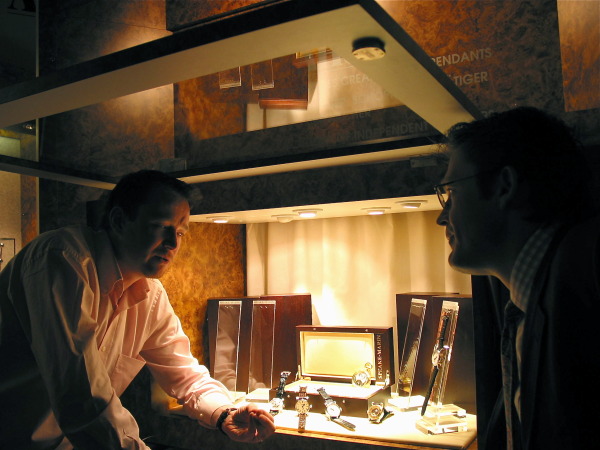
Basel 2004 Peter & I discussing his creations at the AHCI stand.
His watches were stunning and I wanted to help promote him and sell his watches to our collector clients, who I was fairly sure would be as compelled with Peter and his watches as I was. Committing to buy 5 watches, 3 gold and 2 steel classic Piccadilly pieces, with 4 enamel dials and one hand frosted, I was going out on a bit of a limb professionally. It was a fairly significant chunk of our open to buy dollars being spent on a completely unknown then watchmaker, whose products we had to pay up front for before he would ship them over to California. No glossy catalogs, Facebook or a fantastic website like he has now with which to market and promote his amazing work. Just a few rudimentary photos I managed to snap in Basel, which are in this message for you to see, and my enthusiasm!

Basel 2004, his only model, the 38mm Piccadilly with three dial variants, enamel (top) Hand frosted solid 18K three layer dial (middle) & hand engraved solid 18K three layered dial (Bottom)
Intrigued to find out if I was correct, I talked about the watches we ordered that first year in 2004 for several months after Basel, to as many watch aficionados as I could. When the FedEx box arrived in September, we had several collectors, and you know who you are, eagerly awaiting in the store to see these first pieces from Peter. Three left that day to new homes within a couple of hours of the FedEx truck leaving!
I have to say I was rather excited about this, as one doesn't know if that "leap of faith" one takes is a good decision or not, until the market reacts. Suffice to say it propelled me on a path, that to this day I am thrilled to say is the one I'm staying on the watch world. Getting to know the watchmakers personally and finding out why they create their life's work is pretty compelling to me, after all there are many "things" one can spend money and resources on, and to support artisanal watchmaking at this level is very satisfying.
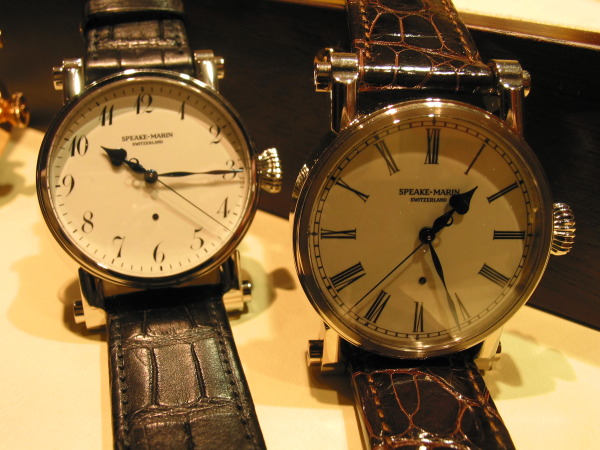
Basel 2004, the two enamel options, stylish arabic or the lovely elongated romans
On that note I'll end off, but before I say goodbye, please consider where you buy your next timepiece, remember the people who help you and have steered you well and most importantly, who value you as a client/friend and not just some sales target to make. There are still a few of us in this business that value the relationship over the dollar. I think you know where I stand.
Cheers,
Tim
Stephen McGonigle visits CA
I have known this genius of a watchmaker for 7 years now, having met him on that serendipitous visit to Dublin in July of 2006. See my article from that trip under the "Watchmaker & Workshop visits':
http://www.independentintime.com/watchmakerworkshop-visits/2009/5/27/ireland-land-of-guinness-and-true-genius-watchmaking-talent.html
Here we are now, delivering to my mind the most elegant and sublime Tourbillon made by anyone. The execution in rose gold with the darkened rhodium plating on the mainplate under the synthetic sapphire crystal dial, really works well together to create this:

Photo courtesy of McGonigles
Stephen, together with his brother John, have been creating their next generation of McGonigle watches, this model is a time only piece, skeletonised for the intitial variation. The Tuscar cased in white gold, with a sapphire crystal dial sits atop the open bridge work to reveal the stunningly hand finished german silver. This long sold out subscription series of 10 watches are close to being completed and will adorn the wrists a little later this year. In the meantime, here a couple of images of the prototype Stephen brought with him.

Notice the circular grain fine finish on the balance bridge, which is centered on the balance wheel bearing. A very large free sprung balance of John & Stephen's design, beating away at 18,000bph, it is a lovely caliber to observe.

This is the official picture of the serially produced One of Ten Tuscar.

The back revealing the now solid main plate, where previously in the proto's they had an opening.
As is the typical path of these Independent watchmakers, the desire to design and execute one's own caliber is a big goal, with many obstacles in the pathway. However, those that do persevere and realize their ambition, will be rewarded and acknowledged by a select few aficionados who recognize the blood, sweat and tears that go into this process. I find myself on many occasions spending a lot of time explaining to watch collectors, unaware of the real difference between an Independent watchmaker, Independent watch companies and big brands, the staggering differences in the process of bringing these seemingly similar products to market.
This semi-skeleton initial series of ten pieces cased in 18K WG is long sold out and being delivered slowly but surely. The Tuscar in person is so much more than the pictures and one can see and feel the efforts put into creating this lovely watch. The good news is that there will be another execution of this Tuscar, now in 18K RG with a darkened sapphire dial, that reveals the balance wheel beating at 18,000vph, called the Banu. This is to my mind actually a better looking watch, might have something to do with it having a RG case and a dark dial, which is one of my favourite combinations!

Here is the Banu, love the massive balance wheel free sprung with gold weights slowly oscillating. Held in place by the pincer claw balance cock. Pic courtesy of McGonigle Watches.
As is our way, I had a fun evening with Stephen in Solana Beach, where friends and collectors could really get to see why Stephen and his brother John, create what they do, touch and feel his proto Tuscar and see a local collector's superlative and to my mind, most lovely McGonigle Tourbillon cased in 18k RG.
Collector's Tourbillon in RG.

I was able to spend a fun day showing Stephen and Cathriona around some of the local sights. He is quite an avid nature watcher, so the seals and sea lions in La Jolla provided several hours of amusement:

In closing, I invite you to take a look at these truly stunning watches created by two of the world's most lovely fellows. Honorable and easy to work with, Stephen and John will I hope in years to come get the recognition they so deserve!
Cheers,
Tim
Thomas Prescher and his Nemo Sailor...
Brian A. checks in with an "on location" shot...
Going home so to Speake....
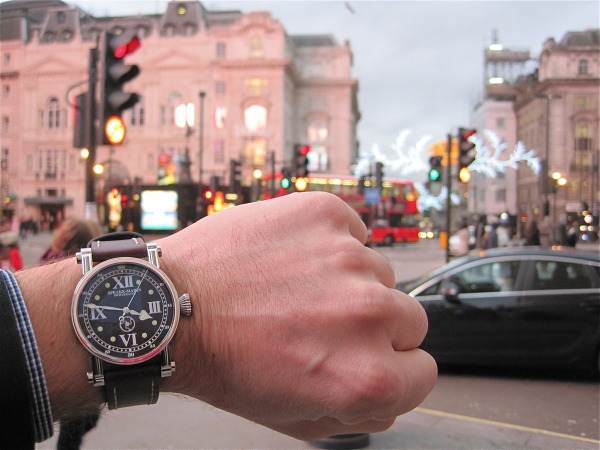
The Spirit Pioneer looking very good on the wrist.
Thanks for sending this Brian! Enjoy a good pint of English bitter for me!
Cheers,
Tim
Huge congratulations to Maria Kristina & Richard Habring!!!
A massive well done for winning the prize in Geneva at the Grand Prix in the sports watch category, for their stunning Doppel 2.0
Please enjoy this video of their win last night in Geneva
I am thrilled for them and honored to be a friend and business partner of theirs.
Cheers,
Tim
